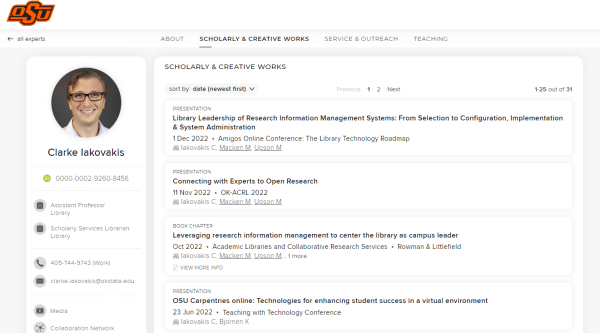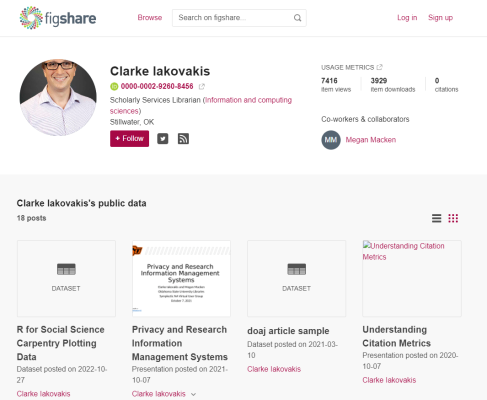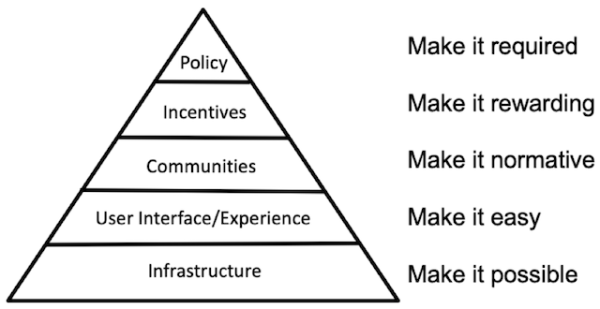As part of our 20th anniversary celebration year, we will be spotlighting a number of Symplectic clients of different sizes and in different regions to take a look at the many ways in which Elements and Grant Tracker are being used to help organisations achieve their research goals.
Oklahoma State University (OSU) is a public land-grant research university in Stillwater, Oklahoma. It is one of five national Sun Grant Centers, receiving millions of dollars in federal funding to explore modern energy challenges and alternative fuel sources. OSU is ranked top 10 nationally and top 100 globally for contributions to the United Nations Sustainable Development Goals.
 Oklahoma State University (OSU) has been a user of Symplectic Elements since 2019, leveraging the system across a broad range of functionality including public profiles for faculty (see https://experts.okstate.edu/), integration with DSpace as an institutional repository, and publications and grants reporting.
Oklahoma State University (OSU) has been a user of Symplectic Elements since 2019, leveraging the system across a broad range of functionality including public profiles for faculty (see https://experts.okstate.edu/), integration with DSpace as an institutional repository, and publications and grants reporting.
We spoke to Clarke Iakovakis, Scholarly Services Librarian at OSU, to learn more about OSU’s use of Elements. Clarke has worked in libraries for over 13 years, and is particularly interested in the areas of scholarly publishing, open access, copyright, programming pedagogy, and bibliometric analysis.
Can you tell us a bit about why OKState made the decision to implement Elements?
While there had been some earlier conversations about the utility of a research information management system, the library really didn’t enter into those conversations in earnest until the fall of 2018. There were some requests by university administrators to have a better broad sense of what our researchers were doing on a more regular basis. Basically how can our campus leaders become more aware of what is going on now and better position themselves to share information about our research with various parties. That was the starting point and we explored our options and had discussions with peer institutions who had adopted various solutions. Elements impressed us with its simplicity, flexibility and control for individual faculty members, and great responsiveness with customer service.
How has Elements helped you in your goal of developing a single source of truth for faculty information? Can you talk about how the API / open interoperability supports this?
Our Elements data feed includes an HR data feed that runs nightly, a publications data feed that runs continuously (including publications databases Scopus, Dimensions, MLA International Bibliography and others), a grants data feed that runs weekly, and a courses data feed that runs once per semester after the last day of classes. We have a repository integration with SHAREOK, our DSpace institutional repository, that harvests publications, data, posters, presentations, and other work created by and deposited to the repository. We received the support of Symplectic staff to develop and establish these feeds–this was a complex process but we benefited immensely from their project management, technical support, and expertise in offering solutions to deal with unique data challenges. We also have begun to populate the Equipment module at the behest of our Vice President for Research in order to enhance discoverability of equipment across campus.
In addition, our Elements team has used the API to add and modify a substantial amount of data; this includes:
- Bulk claiming/rejecting Scopus and ORCID identifiers
- Bulk claiming/rejecting publications on behalf of faculty
- Running a survey to gather faculty degree data and populating that data on behalf of faculty
- Bulk populating and updating institutional appointments (title, department, start date), which are then used top group faculty on the Discovery public profile site
- Adding and modifying web addresses to faculty profiles to link individuals to their departmental web presence
- Harvesting Fields of Research that are linked to publications and adding those tags to faculty profiles for use as filters in Discovery. We also developed our own customized Fields of Research scheme and removed some of the tags specific to Australia & New Zealand.,
- Harvesting Sustainable Development Goals that are automatically linked to publications as part of the Dimensions integration, as well as SDGs harvested from queries in external publications databases, and linking those goals to faculty profiles for use as filters in Discovery
- Reconfiguring the stock Availability tags to convert British English to American English and add additional tags for “Undergraduate Research Supervision;” “Research Design Support;” “Inclusion, Diversity, Equity & Access Support;” and “Art, Design & Music Commissions.”
- Integrating the university web directory with Elements to add a link to faculty Elements profiles and their photograph whenever they make their profiles public
- A huge migration underway to move data from another RIM System on campus into Elements
We have developed an process utilizing either custom API calls developed in the POSTMAN software (and have found the API Collection and support provided by Symplectic to be very useful in creating these), or occasionally we will modify and create XML files in R using xml2 and send the call and upload the files using httr.
Having a single source of truth for faculty information has been immensely beneficial on multiple levels, including publicizing and marketing OSU and OSU scholarship. Over 750 faculty members have made their profiles public and in 2022, according to Google Analytics, there were over 80,000 total clicks from Google results, and our Elements profiles are being linked to from a variety of websites including local and national news outlets, publishers, blogs, and more. It has facilitated more effective and comprehensive data gathering to fulfill university, college, and departmental reporting requirements, described in more detail below.
OKState is a big utiliser of Reporting in Elements – can you share with us some of the insights that you’re able to get into your faculty and research outputs, and how that helps you in demonstrating impact (however you measure impact!) and driving strategic actions/decisions?
Our Elements team has developed an efficient process we use routinely for working with the Elements reporting database. Often we will use R to connect directly to the tables and pull data directly into an RStudio session for manipulating, joining, and analysis. This allows us to make use of the robust data wrangling and visualization tools in R. Much of this work is done for the purposes of quality control and ensuring data integrity, such as deduplication/splitting records and checking linkages between objects and individuals.
We have also built a significant number of custom reports and made those available to select administrators and other users in the Elements user interface. We were very excited to see Symplectic develop the Data Extracts function in Elements, allowing us to upload SQL queries directly to the system. In general we will use Visual Studio to connect to the database and construct and test the queries. Some of these reports include:
- User appointments, departments, identifiers, degrees, certifications, and other administrative data
- Coronavirus publications: Retrieves a dataset of publications including any of the words coronavirus, covid, MERS-CoV, or SARS-CoV in the keywords, abstract, or title fields.
- We worked with an OSU faculty member to develop a list of terms associated with diversity, equity, and inclusion and detect those terms in publications title, abstract, or keywords
We also maintain relationships with communications staff at the department, college, and university level, who work with faculty to publicize and populate their profiles and link them to the university website. These staff find it helpful to run reports on profile completeness and other administrative data. In addition to creating various customized profile completeness reports, we have also created interactive dashboards for all departments displaying similar data, allowing them to focus their support and outreach.
Finally, we have generated various ad hoc reports on specific research topics, used by researchers to assemble teams and write reports for grant reporting and other purposes. In many cases, people at the university aren’t using reporting, but rather keyword searching in Discovery to find people studying topics relevant to them. The library has made use of Elements data as another datapoint in strategic collection development decisions. In general all of this data has enabled us to make better-informed and more cohesive, comprehensive
What is OKState’s response to the Nelson Memo – do you plan on adapting your open access workflows?
The OSU Libraries supports the OSTP’s efforts to maximize public access to scholarship and research data. Thus far we have provided a few workshops on the memo and what it might mean for faculty and others involved with research on campus. We have maintained a long-established and trusted institutional repository, and we have had a Research Data Initiatives Librarian in place since 2018, who has established an excellent foundation for supporting faculty in data management and sharing practices, and we plan on continuing to build out our technical and personnel infrastructure. Already we have seen some inquiries from faculty with regard to the NIH Data Management and Sharing Plan, as well as increasing numbers of journals requiring data sharing, and we expect that to continue growing as funders and publishers push open access forward on a policy level.
The repository integration with Elements provides researchers with an easy and seamless process for depositing their scholarly works and data, and having those items openly available, crawled in Google Scholar, and linked to their public profile page. We have also done some work to import metadata records for openly available datasets to faculty profiles, and Elements allows faculty to link to their Figshare profile if they use that tool.
Referencing the graphic in the Center for Open Science’s Strategy for Culture Change document, we feel that we have the base of the pyramid well covered in terms of supporting faculty who wish to provide open access to their work: the infrastructure and interface in place make it both possible and easy. Certain communities (for example, certain disciplines, departments, research groups) have adopted these norms. Some are intrinsically motivated; whereas open access is becoming increasingly extrinsically incentivized, as discussed above. Should there be any top level policy changes we feel that we will be well-prepared.
How have you seen the day-to-day expectations on researchers & faculty change during your career?
There’s definitely been more of a shift in expectations that our researchers cross departmental and disciplinary boundaries as they explore opportunities for impactful and meaningful research. Elements has already proven to be a useful tool in these efforts as faculty are able to explore expertise and experience quickly and easily. How can we help connect people?
Faculty also are being required to interact with and transfer their data between more and more information systems as a function of publishing and submitting grants and other day-to-day work. These routine administrative tasks that require reusing and repurposing their own data can eat up a lot of time, and it’s clear that Elements–and in particular it’s read/write integration with ORCID–can help cut down on this time, especially as ORCID is linked to SciENcv and as federal agencies implement NSPM-33.
Equally, how have you seen the role of the Library change during that time?
Like all academic libraries, we’ve been attempting to broaden the perception of the library past what people have traditionally expected. That’s not to say we’ve sought to replace many of the things we’ve historically done, but simply entered areas of influence that make sense for our community and building capacity for those efforts as we work. Elements is definitely part of that exploration and has provided us an entry point into conversations about scholarly communications, research impact, author rights, open access and more. These are areas we have already been focusing on, but the system has provided that additional point of contact between the library and our researchers.


